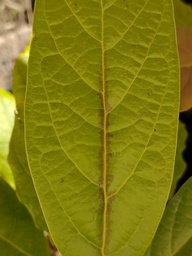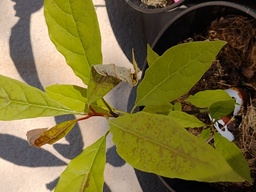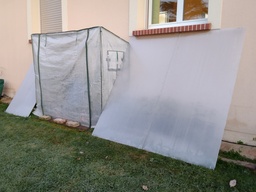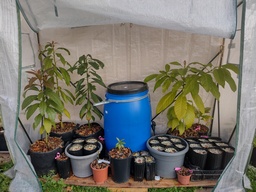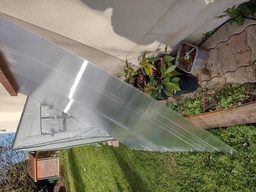Winter protection
Radiative cooling
The most important concept to understand when it comes to how and when frost and frost damage occurs is that of radiative cooling. In day-to-day life we usually deal with heat conduction, which is how heat transfer between objects that are directly touching each other. However, everything is also always losing heat by emitting infrared radiation; this is actually how the sun heats up the Earth.
Radiative cooling happens outside on a clear night when the ground emits heat as radiation into the sky. In fact, anything that has a clear view of the sky will emit infrared radiation into space. Infrared radiation does not penetrate solid objects, but will be reflected; this is why it’s so important to enclose things that you want to stay warm. Even just blocking half the sky by putting a tree close to the wall of a house will cut the radiative heat loss by about half.
One thing that really blew my mind is the fact that infrared radiation travels at the speed of light; we’re so used to thinking about conductive heat transfer that it’s hard to imagine radiative cooling as being almost instant, but the fact is that a light cloud cover will reflect the infrared radiation from the Earth back to the ground in a matter of microseconds.
Cold damage
Avocado trees sustain essentially two main types of cold damage: foliar or stem damage.
The first effects of freezing temperatures is the appearance of brown spots on the leaves, usually polygonal clusters of around 1-2mm in size. This type of damage often occurs along the central vein of the leaf, but can also appear randomly across the leaf. If the frost is hard or severe, the whole leaf will appear burned and turn crispy and black or brown. This kind of leaf damage often appears at the first frost (and at 0°C) on young leaves that have not yet matured and comes mainly from frost and frozen dew rather than the cold temperatures themselves. Frost and frozen dew typically occurs early in the morning as the temperatures drop just before sunrise or when the sky is clear during the night and early morning. It is therefore essential to ensure that trees be covered in some way.
The second type of cold damage is due to very cold temperatures or sustained freezes. In this case the stems themselves die and turn black. Very often, if the temperature does not go below about -9°C or stay frozen for very long, the stem will die back to the ground but the roots will survive and produce a new stem in the following year.
As far as I know, the only way to protect stems from dying is to use a heat source to ensure that they don’t get too cold for too long.
My setup
This is how I protect my trees:
- younger than 3 months: inside the (semi-heated) mini greenhouse
- 3 to 9 months: next to the house, under polycarbonate sheets
- 9 to 24 months: inside the (semi-heated) mini greenhouse or using plant covers
- older than 24 months: plant covers
In general, avocado trees tolerate cold better as they get older and more established. It follows that very young trees or seeds that have just sprouted need the most protection. Avocado seeds that have not germinated will almost certainly die if they freeze through. I therefore keep my seeds and trees younger than 3 months inside the house or inside a semi-heated greenhouse to ensure the temperature cannot go below 0°C.
The semi-heated greenhouse is a small plastic greenhouse with a 120L water barrel and an aquarium heater that is only turned on if I think there is any chance of freezing.
For young trees that have developed some amount of foliage I keep them under polycarbonate sheets (1cm thick) that lean against the house. By staying close to the house I ensure that there is some heat from the house, while the polycarbonate sheets mainly protect against radiative cooling. The polycarbonate sheets also keep some heat from the house and the ground in and slow down air movement, but given that the sides are open these effects are probably minimal.
The polycarbonate sheets do not provide a lot of room underneath, which means that as the trees reach about 12 months I’ll have to move them back out. If there is room in the greenhouse I can keep them there; if not, I can keep them along the side of the house with plant covers to prevent frost on the leaves.
